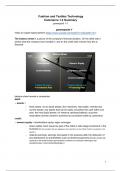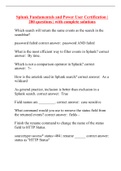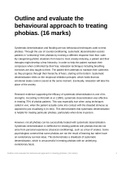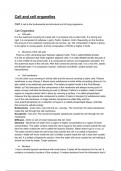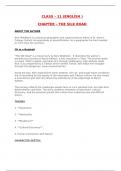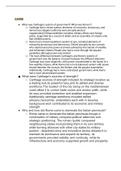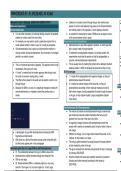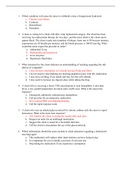Human Resource Management:
HRM & OB deals with the human factor in organizations
Organizational Behavior = Interdisciplinary field dedicated to understanding people at work
(Psychology, Sociology, and management)
Human Resource Management = The policies, practices and systems that influence
employees’ attitudes, behaviors and performance
Organizational Behavior levels:
1. Individual level (What drives people, what motivates them, how do their
personalities influence)
2. Group level (Group dynamics, relatsionships)
3. Organization level (Organizational culture)
These levels facilitate HRM to come up with organizational outcomes
Lecture 1: Attitudes
Attitudes are an important predictor of behavior
Generating positive attitudes increases desired behaviors such as performance,
health and OCB
Generating positive attitudes decreases undesired behaviors such as absenteeism
and turnover
Attitudes are evaluative statements or judgments concerning objects, people, events or
ideas
(Attitudes are learned predispositions to respond in a consistently favorable or unfavorable
manner with respect to an attitude object) official term explanation
,Theory of Planned Behavior (Implementation intentions form Gollwitzer)
Cognitive dissonance: unbalance between cognition, affect, and behavior (intended
behavior and actual behavior)
Cognitive Dissonance theory (Festinger): We try to find replacements for our attitudes that
conform more with our behavior
Most prominent attitudes in organizations:
1. (Job) satisfaction
+ Performance
Absenteeism, deviance
2. Involvement
+ Performance
Absenteeism, Turnover
3. Commitment
+ Performance
Absenteeism, Turnover
4. Perceived Organizational Support (POS)
+ Well-Being, Organizational Identification
Involvement
,Lecture 2: Personality & Diversity
Personality: Combination of enduring physical, behavioral and mental characteristics that
makes individuals unique
Key aspects of personality:
Relatively stable
o Temporal stability
o Cultural stability
Psychological dispositions towards certain behaviors
Highly visible in weak (vs. strong) situations
Determined by genetics and environment (=Interactionists perspective)
Personality as a relatively stable individual difference that predicts work related outcomes
The Big 5 Theory (on personality):
Proactive personality is:
A stable disposition to take personal initiative (e.g., voice opinions, craft your job) in
a broad range of activities and situations
Related to Conscientiousness; Extraversion
Related to Internal Focus of Control
Highly valued in today’s work and career
Generalizable to different cultures
, Dark Triad:
Narcissism
Machiavellianism
Psychopathy
Common Characteristics
Aggressiveness
High extraversion and openness (fearless)
Low conscientiousness and agreeableness
Low emotional empathy
Self-promotion (not humble)
Higher probability for anti-social behavior
What is Diversity? (Gardenswartz & Rowe)
Closer to the center > Harder to change
Surface Level Diversity:
Differences in easily perceived characteristics
E.g., gender, ethnicity, age
Does not necessarily represent the way people think or feel
Stereotypes
Deep Level Diversity
Differences in harder to see characteristics
E.g., values, beliefs, and work preferences
Becomes progressively more important as people get to know each other
Affirmative action: intervention aimed at giving management a chance to correct past
imbalance, injustice or discrimination
HRM & OB deals with the human factor in organizations
Organizational Behavior = Interdisciplinary field dedicated to understanding people at work
(Psychology, Sociology, and management)
Human Resource Management = The policies, practices and systems that influence
employees’ attitudes, behaviors and performance
Organizational Behavior levels:
1. Individual level (What drives people, what motivates them, how do their
personalities influence)
2. Group level (Group dynamics, relatsionships)
3. Organization level (Organizational culture)
These levels facilitate HRM to come up with organizational outcomes
Lecture 1: Attitudes
Attitudes are an important predictor of behavior
Generating positive attitudes increases desired behaviors such as performance,
health and OCB
Generating positive attitudes decreases undesired behaviors such as absenteeism
and turnover
Attitudes are evaluative statements or judgments concerning objects, people, events or
ideas
(Attitudes are learned predispositions to respond in a consistently favorable or unfavorable
manner with respect to an attitude object) official term explanation
,Theory of Planned Behavior (Implementation intentions form Gollwitzer)
Cognitive dissonance: unbalance between cognition, affect, and behavior (intended
behavior and actual behavior)
Cognitive Dissonance theory (Festinger): We try to find replacements for our attitudes that
conform more with our behavior
Most prominent attitudes in organizations:
1. (Job) satisfaction
+ Performance
Absenteeism, deviance
2. Involvement
+ Performance
Absenteeism, Turnover
3. Commitment
+ Performance
Absenteeism, Turnover
4. Perceived Organizational Support (POS)
+ Well-Being, Organizational Identification
Involvement
,Lecture 2: Personality & Diversity
Personality: Combination of enduring physical, behavioral and mental characteristics that
makes individuals unique
Key aspects of personality:
Relatively stable
o Temporal stability
o Cultural stability
Psychological dispositions towards certain behaviors
Highly visible in weak (vs. strong) situations
Determined by genetics and environment (=Interactionists perspective)
Personality as a relatively stable individual difference that predicts work related outcomes
The Big 5 Theory (on personality):
Proactive personality is:
A stable disposition to take personal initiative (e.g., voice opinions, craft your job) in
a broad range of activities and situations
Related to Conscientiousness; Extraversion
Related to Internal Focus of Control
Highly valued in today’s work and career
Generalizable to different cultures
, Dark Triad:
Narcissism
Machiavellianism
Psychopathy
Common Characteristics
Aggressiveness
High extraversion and openness (fearless)
Low conscientiousness and agreeableness
Low emotional empathy
Self-promotion (not humble)
Higher probability for anti-social behavior
What is Diversity? (Gardenswartz & Rowe)
Closer to the center > Harder to change
Surface Level Diversity:
Differences in easily perceived characteristics
E.g., gender, ethnicity, age
Does not necessarily represent the way people think or feel
Stereotypes
Deep Level Diversity
Differences in harder to see characteristics
E.g., values, beliefs, and work preferences
Becomes progressively more important as people get to know each other
Affirmative action: intervention aimed at giving management a chance to correct past
imbalance, injustice or discrimination

